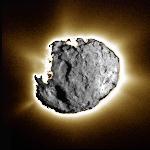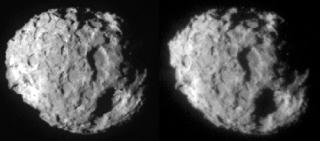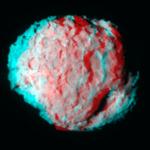
|
 |

Image 1. This composite image was taken by the navigation camera during the close
approach phase of Stardust's Jan 2, 2004 flyby of comet Wild 2. Several
large depressed regions can be seen. Comet Wild 2 is about five kilometers
(3.1 miles) in diameter. To create this image, a short exposure image
showing tremendous surface detail was overlain on a long exposure image
taken just 10 seconds later showing jets. Together, the images show an
intensely active surface, jetting dust and gas streams into space and
leaving a trail millions of kilometers long.
|
Composite and Stereo Images of Comet Wild 2
March 17, 2004
On 2 January 2004, NASA's Stardust spacecraft successfully
survived flying through the coma (dust and gas cloud) surrounding
comet 81P/Wild 2, captured thousands of fresh cometary dust
particles released from the surface just hours before, and is now on
its way home for Earth return set for January 2006. During the
flyby, the highest resolution images ever taken of a comet's
nucleus were obtained and have been the subject of intense study
since the flyby. A short exposure image showing
tremendous surface detail was overlain on a long exposure image
taken just 10 seconds later showing jets (Image 1). "This
spectacular composite image shows a surface feature unlike any other
planetary surface see to date in our solar system", says Prof Donald
Brownlee, the Stardust Principal Investigator from the University of
Washington. "Other than our sun, this is currently the most active
planetary surface in our solar system, jetting dust and gas streams
into space and leaving a trail millions of km long."
Two other images are shown as a stereo
pair and also as a red/green stereo anaglyph (Images 2 & 3). "The overall shape of
the nucleus resembles a thick hamburger patty with a few bites taken
out", says Thomas Duxbury, the Stardust Project Manager from JPL.
"The surface has significant relief on top of this overall shape
that reflects billions of years of resurfacing from crater impacts
and out gassing".
Preliminary scientific results obtained from the Wild 2 encounter
are being presented at the Lunar and planetary Science
Conference in Houston, Texas by the Stardust science team.
 
Image 2 (left): Stereo image pair of comet Wild 2
Image 3 (right): Red/green stereo anaglyph
|
Stardust will bring samples of comet dust back to Earth in January 2006 to
help answer fundamental questions about the origins of the solar system.
Additional information about the mission is available online at
http://stardust.jpl.nasa.gov
Lockheed Martin Astronautics, Denver, Colorado,
built and operates the Stardust spacecraft.
The principal investigator is
astronomy professor Donald E. Brownlee of the University of Washington
in Seattle.
Stardust is a part of NASA's
Discovery Program of low-cost, highly focused science missions. JPL, a
division of the California Institute of Technology in Pasadena, manages
the mission for NASA's Office of Space Science, Washington, D.C.
Last Updated: May 05, 2004
|
